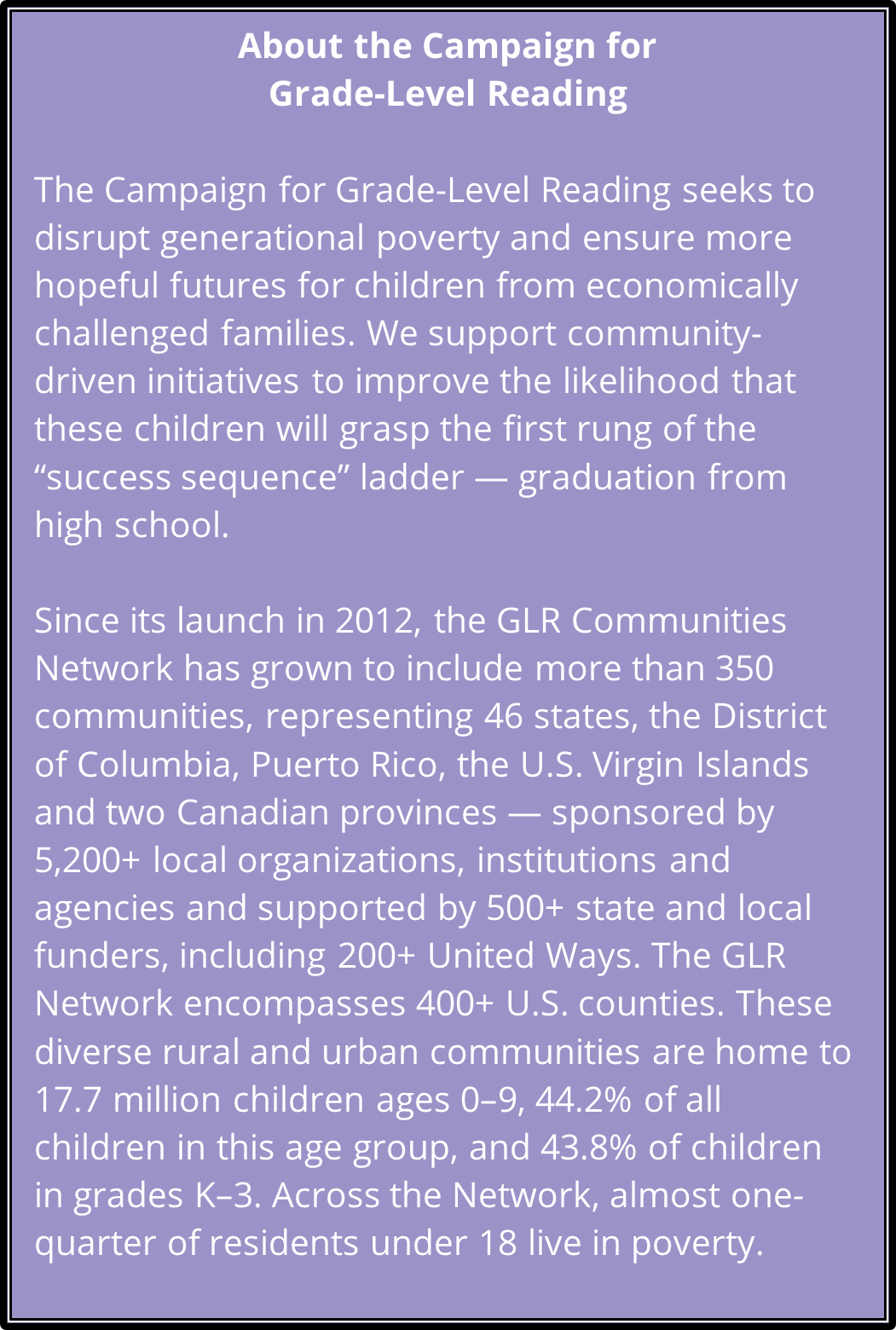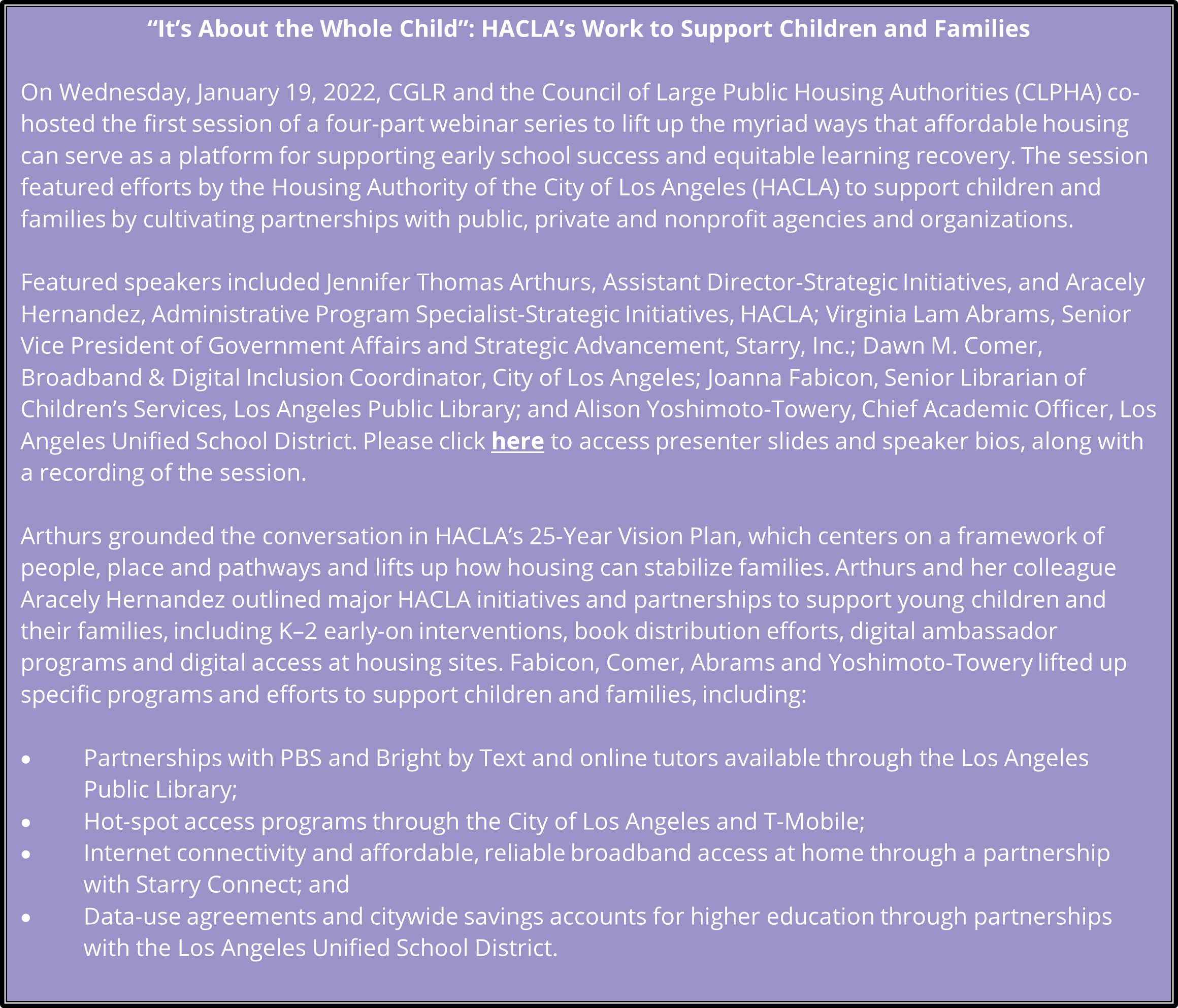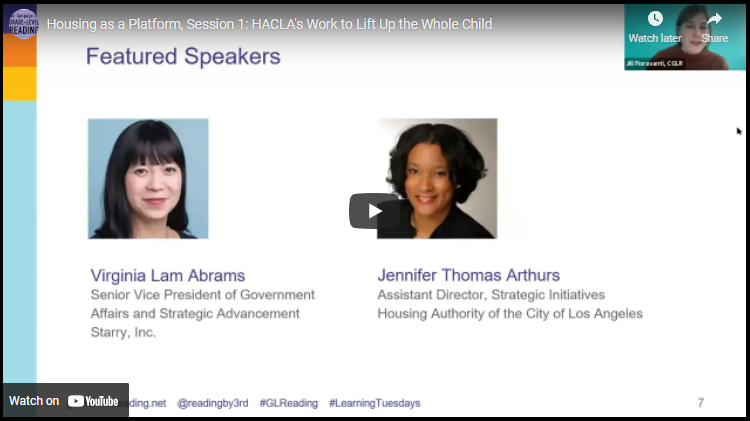By Ralph Smith
How confident are you that the children of economically challenged, fragile and marginalized families in the neighborhoods you care about are receiving the services for which they are eligible in a manner that is properly sequenced, at the appropriate dosage and for the necessary duration? Are you very confident, somewhat confident or not at all confident?
This question arose out of the 2017–18 Listening Tour conducted by the Campaign for Grade-Level Reading (CGLR) that engaged 49 communities in our Network in two-way conversations about the work of CGLR and the communities themselves. At that time, 78 of participants replied that they were “not at all confident.” The question has become all-the-more important and urgent since the start of the COVID-19 pandemic. Today, 88 of community partners fall in the “no confidence” category, and it explains in large measure why the changes we seek in early school success remain elusive at the population level.
Success Requires 24/7/365/Multigenerational Systems of Services and Supports
The children of economically challenged, fragile and marginalized families require not only good schools but also key services and supports to achieve early school success. This realization was built into CGLR from the outset, expressed in the call for more seamless systems of care, services and supports. Over time, this priority grew into the more powerful notion of surrounding families with 24/7/365/multigenerational systems of services and supports.
schools but also key services and supports to achieve early school success. This realization was built into CGLR from the outset, expressed in the call for more seamless systems of care, services and supports. Over time, this priority grew into the more powerful notion of surrounding families with 24/7/365/multigenerational systems of services and supports.
However, schools generally operate six to eight hours a day, five days a week, for 10 months each year, and they are multigenerational only sometimes (often under duress). Moreover, the connections between and among schools and other service providers are notoriously fragmented. To assure changes in outcomes, school-centric solutions are not sufficient; it also is necessary to align, stack and bundle efforts by multiple agencies and systems. Increasingly, public housing has emerged as a crucial platform, springboard and catapult for such systems.
Why Engage Public Housing?
The notion of “meeting children and families where they are” has become a mantra for the entire child and family-facing field. In this case, meeting children and families where they are begins quite literally with where they live:
- More than 10 million people in 5.2 million low-income households, including nearly 4 million children, rely on some form of federal rental assistance.1
- Within this population, 1.8 million people including 660,000 children (ages 0–18) live in one of the nation’s 958,000 public housing units.2
Public housing agencies (PHAs) and affordable housing organizations can serve as focal points and catalysts to bring together public, corporate and community-level stakeholders to promote early school success and equitable learning recovery using a system of 24/7/365 wraparound services and supports and a multigenerational approach.
CGLR’s partnership with public housing is not new. In 2012, a number of public housing executives and leaders of the National Association of Housing and Redevelopment Officials’ education committee attended the launch of the GLR Communities Network at the All-America City Awards ceremony in Denver, Colorado. These public housing executives encouraged CGLR to ensure that the families they served were included in CGLR’s development of initiatives for promoting school readiness, school attendance, summer learning and grade-level reading.
CGLR responded by encouraging the then-emerging network of local communities to include public housing agencies in the local sponsoring coalitions. CGLR also committed to work with and through the housing leadership organizations, including National Association of Housing and Redevelopment Officials (NAHRO), the Council of Large Public Housing Authorities (CLPHA) and the Public Housing and Affordable Housing Association (PHADA), and with the U.S. Department of Housing and Urban Development (HUD).
Over the ensuing years, these partnerships enabled CGLR, working in close proximity with public housing leaders and agencies across the nation, to facilitate, endorse and applaud the multiple ways PHAs were stepping up for children and demonstrating that they can make a difference. CGLR formalized this relationship in 2016 via a Memorandum of Understanding with HUD. CGLR has continued engaging with national public housing associations in a variety of ways to provide opportunities for peer learning and to share bright spots and exemplars. These efforts have included:
- Organizing and presenting at state, regional and national NAHRO conferences and at CLPHA Housing Is Summits to increase visibility and understanding of this issue across a wide network of public housing leaders;
- Co-hosting national webinars focused on housing as a platform (see the below callout for the summary of a recent session) to highlight what’s working locally and expose housing and education audiences to national thought leaders;
- Lifting up the link between housing and early school success in CGLR publications;
- Advancing this conversation through working groups led by public housing leaders across the country, in conjunction with national housing associations; and
- Recognizing PHAs working in this space to celebrate public housing agencies and their contributions to early school success.
An Enhanced Sense of Urgency
The abrupt closing of schools, early childhood programs, and childcare centers to contain COVID-19 undoubtedly saved thousands of lives. However, the school closures and shift to online learning have left even more kids stranded on the wrong side of even wider learning and achievement gaps. McKinsey & Company examined the spring 2021 assessment results for 1.6 million elementary students across more than 40 states and compared them to results for similar students tested during the three years before the pandemic (2017, 2018, 2019).3 The data analysts found that:
- On average, students ended the school year 10 points behind in math and 9 points behind in reading, compared with previous years. This translates into a loss of 5 months of math learning and 4 months of reading progress.
- Students of color and kids in low-income families are losing the most ground. McKinsey found that students in majority-Black schools ended the school year 6 months behind in both math and reading, while students in majority-white schools were 4 months behind in math and 3 months behind in reading.4
- Students in low-income families lost nearly twice as much ground as their peers from more affluent families: 7 months in math and 6 months in reading, compared with 4 and 3 months, respectively, for kids from more affluent families.5
Meanwhile, data collection and analyses by experts like Phil Fisher of the University of Oregon’s Stress Neurobiology & Prevention Lab underscore the pandemic’s disproportionately damaging effect on the well-being of children in lower-income households. Fisher leads the ongoing Rapid Assessment of Pandemic Impact on Development-Early Childhood (RAPID-EC) Project, which surveys households and providers of early childhood services to gauge effects on the development of children from birth to age 5, caregiver mental health and well-being, and caregiver needs and utilization of resources.6 The project has found that:
- Children are showing more externalizing behaviors (44 percent of children) and internalizing behaviors (17 percent of children) that indicate decreased well-being than before the pandemic, according to caregivers.7
- 19 percent of parents who use center- or home-based childcare have experienced disruptions in care for their children, leading to higher levels of emotional distress (a composite of depressive, anxiety, stress and loneliness symptoms) and behavioral problems in their young children.8
- In families with high levels of hunger, parents report having high levels of emotional distress and lower well-being among their children.
These findings foreshadow a potentially catastrophic future for children from economically challenged families. Furthermore, promises to “build back better” and to reimagine and reinvent institutions and systems to address preexisting issues may have given rise to legitimately heightened — but probably unrealistic — expectations for what the new normal could look like and achieve. The high expectations will make it difficult to accept the fact that even though hundreds of programs across the country are reporting progress and success on outcomes, there is little or no discernible progress at the population level.
Given the widening learning and achievement gaps, there is an urgent need to do more, better and differently. CGLR’s decision to join with the National Civic League to focus the 2022 All-America City (AAC) Awards on Housing as a Platform represents “staying the course” and doubling down on the commitment made in 2012 — to ensure that children of the economically challenged families served by publicly subsidized housing are not left behind, especially given the ravages of the pandemic. It is also part of CGLR’s commitment to try to identify promising and powerful strategies that have “leapfrog” potential. Among them are promoting digital equity, providing relational supports, expanding teacher coaching by board-certified peers, scaling community schools, and equipping parents to succeed in their role as full-fledged and essential partners in their children’s learning. A number of these priorities were incorporated into the criteria for the 2022 AAC Awards.
The 2022 All-America City Awards
Now in its 73rd year, the 2022 AAC Awards will recognize communities that have committed to improving the prospects for early school success and equitable learning recovery for the hundreds of thousands of children whose families are served by the nation’s PHAs and affordable housing organizations.
The 2022 AAC Award winners will be announced the week of July 18 in conjunction with GLR Week. Communities and their housing partners will be celebrated for their work in one of the following seven areas of focus that reflect the comprehensive and wide range of ways that affordable housing agencies and organizations can support children and families:
- Digital equity (internet access, individual devices, technical assistance);
- Relational supports (tutors, mentors, coaches);
- Afterschool, summer and out-of-school learning opportunities;
- Transforming non-school places and spaces into learning-rich environments;
- Promoting school readiness, regular attendance and summer learning;
- Parents succeeding as essential partners in assuring the healthy development and early school success of their children; and
- Parents succeeding in their own journey toward sustainable self-sufficiency.
Highest priority will be given to proven, promising and/or innovative programs and initiatives that are supported by interagency, cross-sector and broadly inclusive stakeholder coalitions; engage public housing agencies and/or affordable housing organizations; feature interagency agreements for data sharing, the braiding and blending of funding, cross-sector approaches for problem solving and smart decision making, and/or strategic deployment of civic capital (relationships, networks, capacities); and have an explicit focus on promoting racial equity and/or improving the prospects for children of color and economically challenged, fragile and otherwise marginalized families.
As the linchpin of what we expect to become a multifaceted strategy, CGLR is betting that the 2022 AAC Awards will prove as catalytic for the notion of housing as a platform as the 2012 AAC Awards were for the successful launch of the GLR Communities Network. While this is an effort co-sponsored with National Civic League, we are grateful for the partnership and support of NAHRO and CLPHA.
Looking Forward
As CGLR’s Housing as a Platform initiative moves forward in 2022, CGLR is looking at promising exemplars of initiatives, programs and partnerships that are transforming public housing communities into places that prepare young children to achieve in school, caregivers to succeed as parents and families to move to self-sufficiency. CGLR hopes and expects that the partnership with National Civic League and our affiliation with this prestigious award will inspire the formation of a diverse coalition of willing communities that “raise their hands” to self-nominate and commit to ambitious efforts, programs and initiatives. And we are betting that by partnering with National League of Cities (NLC), we will secure the engagement and leadership of local public officials who will see our approach to early school success and equitable learning recovery as important contributors to advancing and accelerating their efforts toward community recovery and resilience.
Ralph Smith is managing director of the Campaign for Grade Level Reading.





